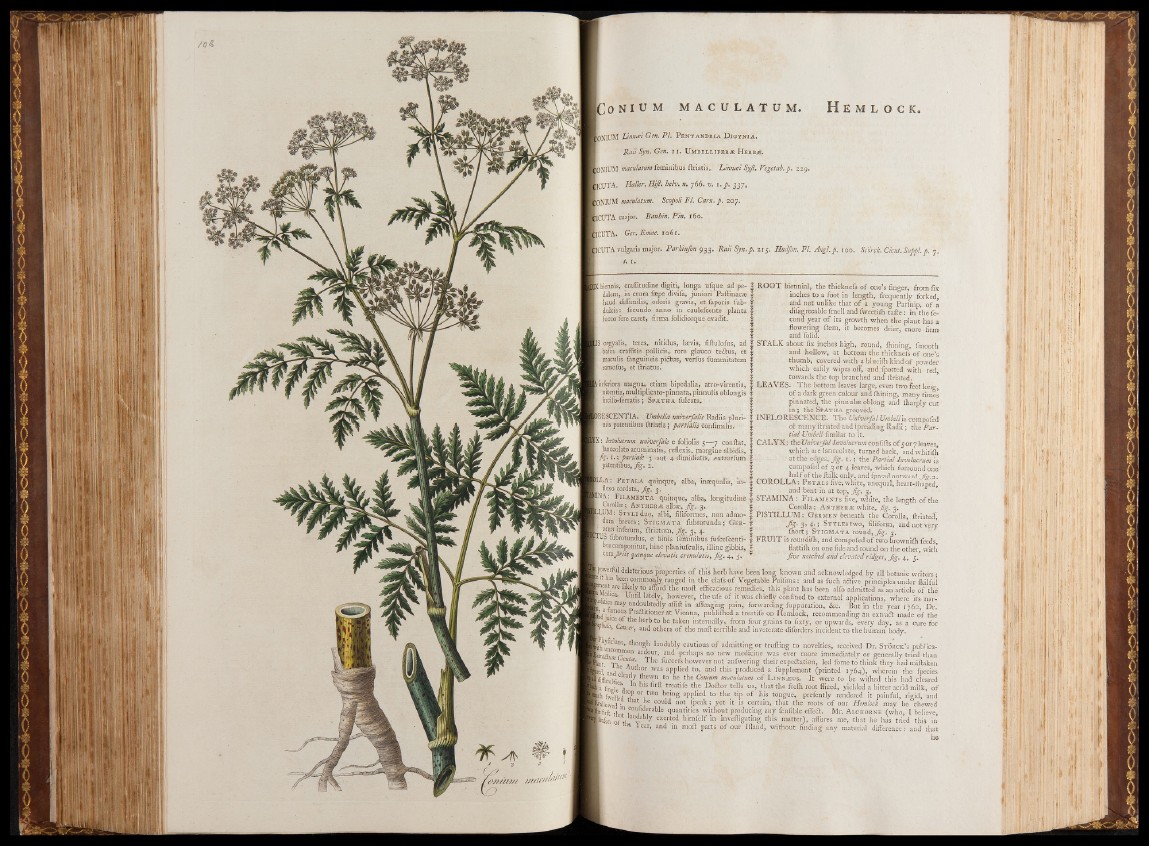
CONIUM MACULATU M. HEMLOCK
(ONIUM Linnai Gen. PL Pentandria Digyn ia.
Raii Syn. Gen. u . Umbelliferæ Herbæ.
SoNîUM maculatitm fëminibus ftriatis. Linnai Syß. Fegetab.p. 229.
JCUTA. Haller. Hiß. helv. n. 766. v. i.p . 337,
§)NIUM maculatum. Scopoli FL Carn. p. 207.
WCUTA major. Bàuhin. Pin. 160.
ÿCUTA. Ger. Emac. 1061.
IcUTA vulgaris major. Parkinfon 933. Raii Syn.p. 215. Hudfon. F l Angl.p. 100. Stôrch Cicut. Suppl, p. 7.
$. H
biennis, craflitudine digiti, longa ufque ad pe- | ROOT biennial, the thicknefs of one’s finger, from fix
dalem, in crura fepe divifa, juniori Paftinacas . inches to a foot in length, frequently forked,
haud diffimilis, odoris gravis, et faporis. fub- and not unlike that of a young Parfnip, of a
dulcis: fecundo anno in caulefcente planta | difagreeable fmell and fweetifh tafte: in the fefucco
fere caret, firma folidiorque evadit. | cond year of its growth when the plant has a
flowering ftem, it becomes drier, more firm
$ and folid.
Js orgyalis, teres, nitldus, lasvis, fiftulofus, ad | STALK about fix inches high, round, Aiming, fmooth
I bafiu craffitie '.paUicisj. rare glauco teftus, et | and hollow, at bottom the thicknefs of one’s
I maculis fanguineis piftus, verfus fummitatem | . thumb, covered with a blueifh kind of powder
| - which eafily wipes off, and /potted' with red
, I towards the top branched and Aria ted. ’
Jinfetiora magna, etiam bipedalia, atro-virentia, | LEAVES. The bottom leaves large, even two feet long,
I ■ riitentia,multiplicato-pinnata,pinnulis oblongis f of a dark green colour and (hilling, many times
incifo'/erratis; Spatha fulcata. | pinnated, the pinnulae Oblong and (harply cut
■ • I ' f-. ■■■'! ■'■ in; the Sp at ha grooved.
IRESCENTIA. TJmbella univerfalis 'Radns pluri- | INFLORESCENCE. The UniverfalUmbell is compofed
mis patentibus ftriafis-; partialis eonfimilisv | .• of many ftriated and fpreading Radii; the Par-
_ .1 ^ ? tial Umbellfimilar to it.
BX: InVolacrutn uniyerjale e foliolis 5— 7 conftat, | CALYX.: th&Univer/al Invo/uerum conC\As of^ or 7 leaves,
lanceolato acuminatis, reflexis, margine albidis, | which are lanceolate, turned back, and whitifh
M‘ i -1 fartiak 3 ant 4 dimidiate, .extrorfurh | . .a t the edges, fig. 1.; the Partial Involucrum is
patentibus, fig. 2. , | compofed o f 3 or 4 leaves, which Wound one'
•fc. • • . v. - . - . , • I .. . half of the ftalk only, and fpread outward, fig. 2.
jLLA: Pet ala quinque, alba, inasqualia, in- $ COROLLA: Petals five,white, unequal, heart-fhaped
Ima ° cor<^ata» ^ ' 3- . | and bentin at top, fig. 3.
JNA: Filamenta quinque, alba, longitudine | STAMINA : Filaments five, white, the length of the
I t H I Anthers alb«, fig.. 3. .. , , Corolla; A nthers white, fig. 3.
Styli duo, albi, filiformes, non adrao- | PISTILLUM: Germen beneath the Corolla, ftriated’
dutri breves ; Stigmata fubtbtunda; G'fik- 1 fig. 3, 4.; Styles two, filiform, and not very
^m fb r am r f t r ia tum ,^ ^ ^ . I fhort; Stigm a ta round, fig- 3.
US fubrotundus, e'biriis ^minibus fufcefcenti- J FRUIT is roun'difh, and compofed o f two brownifh feeds,
bus componitur, hinc planiufculis, illinc gibbis, ,| flattifh on one fide and round on the other, with
cmfiriis qutnque ekvatis crenulatis, Jig. 4, 5. *■ five notched and elevated ridges, fig. 4, 5/
»powerful deleterious properties of this herb have been long known and acknowledged by all botanic writers ;
®11 | p ^ncomm^fj:.imaged in the, claf&of Vegetable Poifons: and as fuch adtive principles, under fkilful
J R I p Sp® t0 efficacious remedies, this'plant has been alto admitted as an article of the
MV Ca* R S ^atev »" 'however,' theufe of it"Was chiefly confihed to external applications, where its nar-
I i ies may undoubtedly affift in affuaging pain, forwarding fuppiiration, &c.' * 1 But in the year 1760, Dr.
led i am°us Practitioner at Vienna, publifhed a treatife on Hemlock, recommending an extrad made of the
mb' I C*p “le herb to be taken internally, from four grains to fixty, or upwards, every day, as a cure for
Y u a’ ■ ^ 5 an<l others of the moft terrible and inveterate diforders incident to the human body.
Jhyficians, though laudably cautious of admitting or trufting to novelties, received Dr. Storck’s publica-
Waau2 ? 0n H I Pei‘laaPs no new toedicine was eyer more immediately or generally tried than
|nt L T 16 fuccels however not anfwering their expeftation, led fome to think they had miftaken
B B l B W iW W3S applied to’ and this Produced a fupplement (printed 1764), wherein the fpecies
■ diult;e ' f f - T 1 t0 be the Con,urr maculatum of L innjeus. It were to be wifhed this had cleared
K l l i p l ln hls firft treatife the Doftor tells us, that the frefh root fliced, yielded a bitter acrid milk, of
I I fweUeH ?K <V W0 beinS applied to the tip of his tongue, prefently rendered it painful, rigid, and
«allowed it thaV r COUld D ?Peak ; it is certain, that the roots of, our Hemlock may be chewed
Ifirft ti 1 eoiiuderable quantities without producing any fenfible efFeft. Mr. Alchorne (who, I believe,
B^on of j W i exert.ed himfelf In invefligating this matter), aflures me, that, he has tried this in
me Year, and in moft parts of our Ifland, without'finding any material difference :■ and that
ho